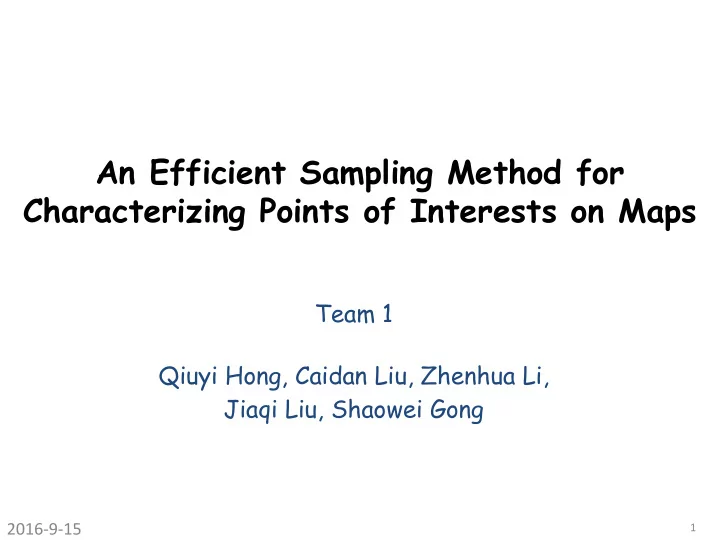

An Efficient Sampling Method for Characterizing Points of Interests on Maps Team 1 Qiuyi Hong, Caidan Liu, Zhenhua Li, Jiaqi Liu, Shaowei Gong
Outline • Background and formulated problem • Challenges • Our methods (i.e., RRZI and RRZIC) • Experiments and Applications • Conclusions
Points of Interests
Background • Google Maps: keyword “restaurant” A PoI: location, rating, flavor, reviews, …
Background • Foursquare: food, nightlife, coffee, shopping, sights, arts, outdoors, … A PoI: category location, rating, Reviews, #check-ins …
Formulated Problem • Objective 1 ➢ Sum aggregate Example 1: f ( p ) is the number of rooms a hotel p has, f s ( P ) is the total number of rooms in the area of interest Example 2: f ( p )=1 f s ( P ) is the total number of hotels in the area of interest
Formulated Problem • Objective 2 ➢ Average aggregate Example: f ( p ) is the average price of a hotel p , f s ( P ) is the average price of hotels in the area of interest
Formulated Problem • Objective 3 ➢ PoI distribution Example: L ( p ) is the star rating of p is the star rating distribution of hotels in the area of interest
Formulated Problem • We focus on designing efficient sampling methods to estimate the above statistics, since it is costly to collect PoIs within a large area. For example, to collect PoIs within 14 cities in Foursquare, Li et al. spent almost two months using 40 machines in parallel.
Challenges • The underlying distribution of PoI is unknown
Challenges • Straightforward sampling method d d 1. Split the region into small sub-regions evenly 2. Random sample sub-regions uniformly
Challenges • Drawbacks of straightforward sampling method ➢ A sub-region may include a large fraction of PoIs ➢ Many empty sub-regions for small d
Our method: Random Region Zoom-in on Maps RRZI( A ) • Input: A , the area of interest ➢ Output: a random sub-region Q with PoIs ➢ less than k and τ 13
Our method: Random Region Zoom-in on Maps RRZI( A ): At each step, RRZI divides • the current queried region into two sub-regions and randomly selects a non-empty sub-region to zoom-in when it contains more than or equal to k PoIs ( k =5) Probability of sampling the sub-region Step 1 Step 2 Step 3 Step 4 14
Our method: Random Region Zoom-in on Maps RRZI( A ): probability of sampling a • sub-region with PoIs less than 5 p( a )=1/2, p( b )=1/4, p( c )=1/4 15
Our method: Random Region Zoom-in on Maps RRZI( A ): three critical questions To divide Q into two non-overlapping To determine whether and are • • regions Q 0 and Q 1 empty regions or not using a minimum • number of queries. If O (observed by pre. Queries) Include both else Query the Not empty sub-region to Otherwise, determine Does RRZI sample PoIs uniformly? If not, • how to remove the sampling bias? No. Use counter 16
Our method: Random Region Zoom-in on Maps RRZI( A ): Estimates the sum aggregate Note: m: Τ(r i ,A): 17
RRZI( A ): probability of sampling a • sub-region with PoIs less than 5 p( a )=1/2, p( b )=1/4, p( c )=1/4 18
Random Region Zoom-in on Maps With Count Information RRZIC( A ): Sample sub-regions with • probability proportional to the number of PoIs. p( a )=2/9, p( b )=4/9, p( c )=3/9 2/9 1 4/7 7/9 3/7 7/9
Our method: Mix Methods • Mix methods: It’s not necessary to apply RRZI and RRZIC into the entire area directly. 1. Split the region into several sub-regions evenly 2. Apply RRZI or RRZIC into random sampled sub-regions Reduce the number of queries
Measure the effect of Sampling • NRMSE(normalized root mean square error): Eliminate the effects of unit and scale of data • Control either the number of queries or error(NRMSE)
Experimental Results • The number of queries required to obtain an estimate of the number of PoIs with NRMSE less than 0.1 our methods mix method
Experimental Results • The number of queries required to obtain an estimate of the average number of Foursquare check-ins with NRMSE less than 0.1 our methods not using PoI count information mix methods our methods using PoI count information
Real application on Google maps • Rating distribution of food-type PoIs within US.
Real application on Foursquare • Statistics of PoIs in US
Real application on Baidu maps • Distribution of hotel-type PoIs’ prices per room per night.
Conclusions • Random zoom-in methods are efficient • Mix methods are more efficient • Methods (e.g., RRZIC) using PoI count information are more accurate.
Thanks !
Recommend
More recommend